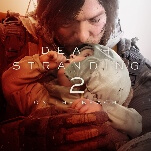Five Places in Games That You’re in No Rush to Leave
There aren’t many videogames that have made me feel genuinely threatened. Violence and melodrama, though intrinsic to games, are often repackaged as simply “part of the experience,” like twists in a rollercoaster ride rather than legitimate emotional down points.
They’re few and far between, but I like games where I’m scared, beleaguered and intimidated. The opening of The Last of Us does this well, as does the Resistance series, at various points. But I think the most effective way to induce a sense of fear or oppression is to contrast the brutal, lively and more aggressive parts of a game with moments of tranquillity and inaction; to make combat and exploration something the player has to physically enter into, rather than the sum total of their experience.
Introduce a player to somewhere calm and peaceful and the outside areas—the “gamey” parts of the game—become more ominous and richly characterised. Perhaps that’s a simple metric, but there are several instances where I feel it really works.
1. Rivet City, Fallout 3
Rivet City is at the southernmost tip of Fallout 3’s map. To get there, you have to push out from Megaton, in the center, and travel through bandit country, a disused subway and finally Washington DC itself—an almost impassable ruin occupied by enemies. The hardship of your journey is contrasted wonderfully by the reveal that Rivet City is actually an old aircraft carrier, lying beached on the shore of the Potomac River. The battery guns don’t work and there are just a few security guards, but still, compared to the tinpot settlements you’ve encountered so far in the Wasteland, this place feels safe. It’s a military installation, or at least, an ex-military installation, and that lends a sense of defensibility. Also, you’re told that the place is inaccessible to intruders, since the guards can raise the gangplank at any sign of danger, thus cutting Rivet City off from the mainland. It’s like a castle with a drawbridge—there are shops, beds and people inside. More than anywhere else in Fallout 3, Rivet City feels like a place that will survive, like a place where you can safely holster your gun and take off your armor. The surrounding DC ruins now seem even less inviting.
2. The Save Room, Resident Evil
I’m referring specifically to the first save room you reach in the first Resident Evil game. The soothing music, the health spray lying on the ground, the clips of ammunition in the chest. Confusion has predominated your first thirty minutes of playing Resident Evil: you don’t understand the puzzles, you’re not sure how to manage your inventory, you don’t even properly understand how moving and aiming work. Resident Evil drops you in the deep end, but the snatched moments spent alone in the save room, catching your breath and checking the instruction manual, are quietly reassuring. But even here, not just in your first save room, but several others, there’s a sense of encroaching horror. The room under the stairs on the first floor, the storage cupboard where you first meet Rebecca, the main hall where your characters first escape from the dogs—it’s telling that these places are all located next to large groups of enemies. The horror in Resident Evil is beating at the door, breathing down your neck. You can escape from it—there are small refuges among the madness—but to free yourself completely you’ll have to wade through a lot more corridors and a lot more creatures. As such, stepping outside of Resident Evil’s save room is always a daunting prospect.
3. Firelink Shrine, Dark Souls
-

-

-

-

-

-

-

-

-

-

-

-

-

-

-

-

-

-

-

-

-

-

-

-

-

-

-

-

-

-

-

-

-

-

-

-

-

-

-

-













































